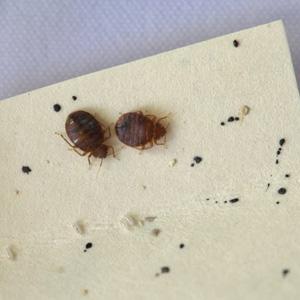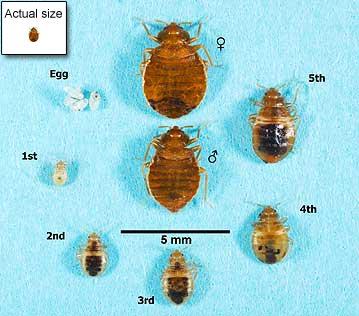Bed Bugs Appearance and Life Cycle
Knowing what to look for is the first step in identifying and controlling bed bugs. There are many bugs that look like bed bugs so an accurate identification is a critical first step to avoid costly treatment for the wrong bug. The types of bugs that look like bed bugs will vary somewhat depending on your region of the country, but photos and descriptions of common look-alikes have been compiled by researchers:
The following links exit the site Exit
- Bat Bugs, Bed Bugs and Relatives (Colorado State University)
- Bed Bugs and Lookalikes (PDF)(1 pp, 619.93 K, About PDF) (Connecticut Agricultural Experiment Station)
- Is it a Bed Bug, Cockroach or Carpet Beetle (PDF) (1 pp, 63.55 K, About PDF) (New York City Department of Health and Mental Hygiene)
Your state cooperative extension service office may also be able to help with identification.
Appearance of Bed Bugs (Cimex lectularius L.)

Two adult bed bugs in a petri dish (courtesy of Kim Jung)
Adult bed bugs, in general, are:
-
about the size of an apple seed (5-7 mm or 3/16 - 1/4 inch long);
-
long and brown, with a flat, oval-shaped body (if not fed recently);
- balloon-like, reddish-brown, and more elongated (if fed recently);
-
a “true bug” (characteristics of true bugs include a beak with three segments; antenna that have four parts; wings that are not used for flying; and short, golden-colored hairs); and
-
smelly, with a “musty-sweetish” odor produced through glands on the lower side of the body.
Young bed bugs (also called nymphs), in general, are:
-
smaller, translucent or whitish-yellow in color; and
- if not recently fed, can be nearly invisible to the naked eye because of coloring and size.
Bed bug eggs, in general, are:
- tiny, the size of a pinhead;
- pearl-white in color; and
- marked by an eye spot if more than five days old.
Bed Bug Life Cycle

Life cycle of the bed bug. Photo Courtesy of Stephen Doggett, Department of Medical Entomology, Westmead Hospital, Sydney, Australia
The life cycle of a bed bug is shown in the photograph below. During its lifetime, a bed bug will go through the following stages (Starting from the top left, moving counterclockwise):
-
Eggs (1mm).
-
1st stage nymph (1.5 mm).
-
2nd stage nymph (2 mm).
-
3rd stage nymph (2.5 mm).
-
4th stage nymph (3 mm).
-
5th stage nymph (4.5 mm).
-
Unfed adult female.
-
Unfed adult male.
